AFT Blog
Modeling Tube Side & Shell Side of a Heat Exchanger
It is possible to model the shell side and tube side of a heat exchanger in AFT Fathom and AFT Arrow where the “hot fluid and cold fluid” circuits can also be included for both sides of a heat exchanger in a single model file! This can be accomplished by creating a "thermal link" between two heat exchangers and using the “Heat Transfer with Energy Balance (Multiple Fluids)” option in the System Properties window.
As shown in Figure 1 below, there are two separate systems modeled on the same Workspace. The left side of the system is an auxiliary cooling water loop while the right side system is the hot oil circulation loop. The two heat exchanger junctions that are highlighted in the red box, J8 and J18, represent the tube side and shell side of a single heat exchanger. The cooling water circuit is on the tube side of the heat exchanger and the hot oil loop is on the shell side of the same heat exchanger. These heat exchanger junctions are “thermally linked” together, as they represent the same physical heat exchanger. Therefore, their resulting heat rates will be the same, but opposite in sign.
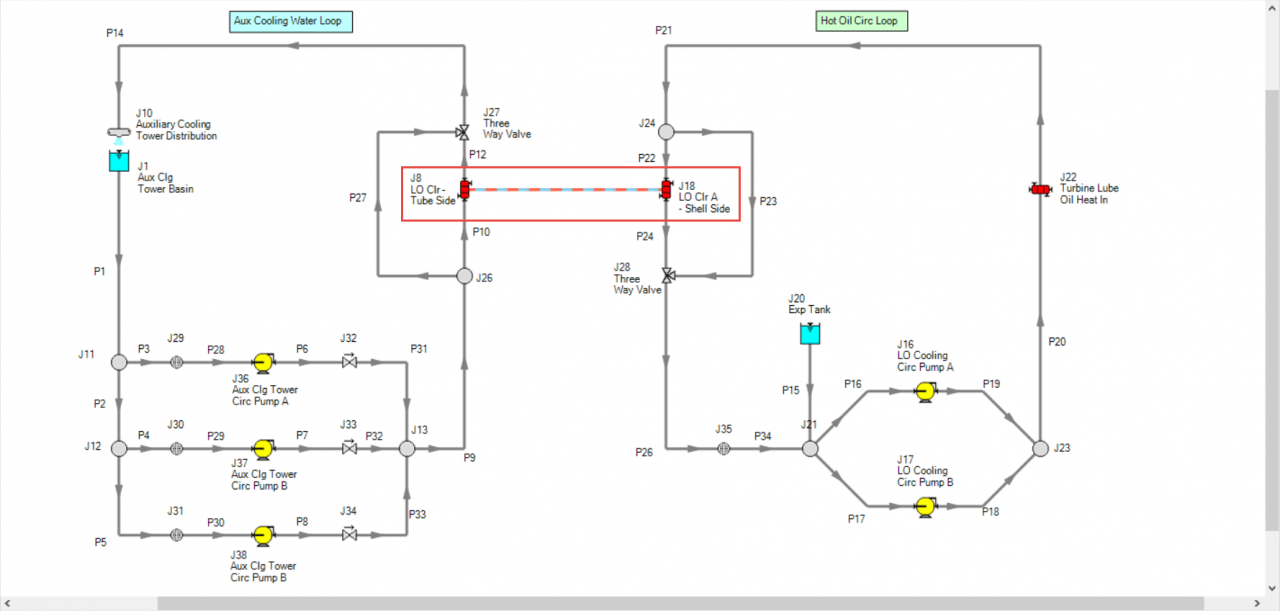
An important requirement to keep in mind that will allow the modeling of two sides of a heat exchanger with the “thermal linking” feature is that both fluids on each side of the heat exchanger must remain in fully liquid phase for AFT Fathom (or fully gas phase for AFT Arrow). Therefore, there cannot be any phase change in either fluid circuit or through the heat exchanger itself.
First step is to build a model of the system and include both cooling water and hot oil loops. After all the pipes and junctions are laid out on the Workspace (but not defined), open up the System Properties window and choose the "Heat Transfer with Energy Balance (Multiple Fluids)" option as displayed in Figure 2. A single “default” fluid must be selected and defined. The individual fluids used in each loop will be defined soon.
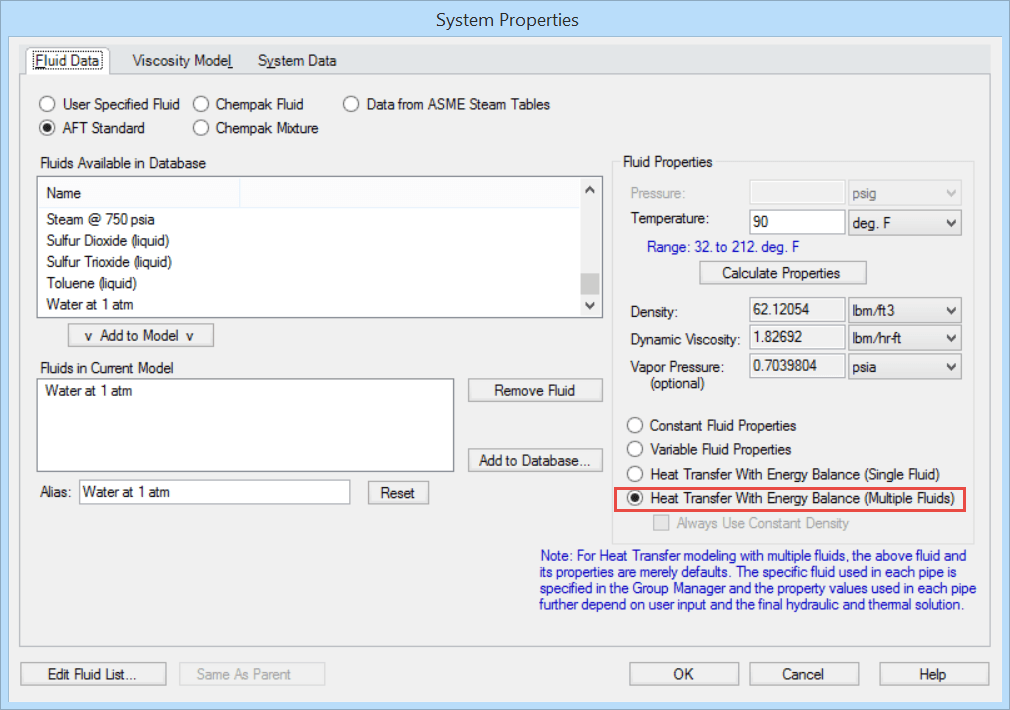
Next, the pipes and junctions can be defined with their various thermal models and characteristics (except for the two heat exchanger junctions that will need to be modeled as two sides of one heat exchanger. This will be specified later).
In order to use the "Multiple Fluids" option in System Properties so that two sides of a heat exchanger can be thermally linked, "Fluid Groups" must be created. Before fluids can be assigned to specific “Fluid Groups”, separate groups of all the pipes and junctions in each individual circuit need to be created first.
As shown in Figure 3, select all the pipes and junctions that make up one of the circuits, such as the cooling water loop. Then from the Edit menu, click "Groups", then "Create", and give that group of pipes and junctions that are selected, a name.
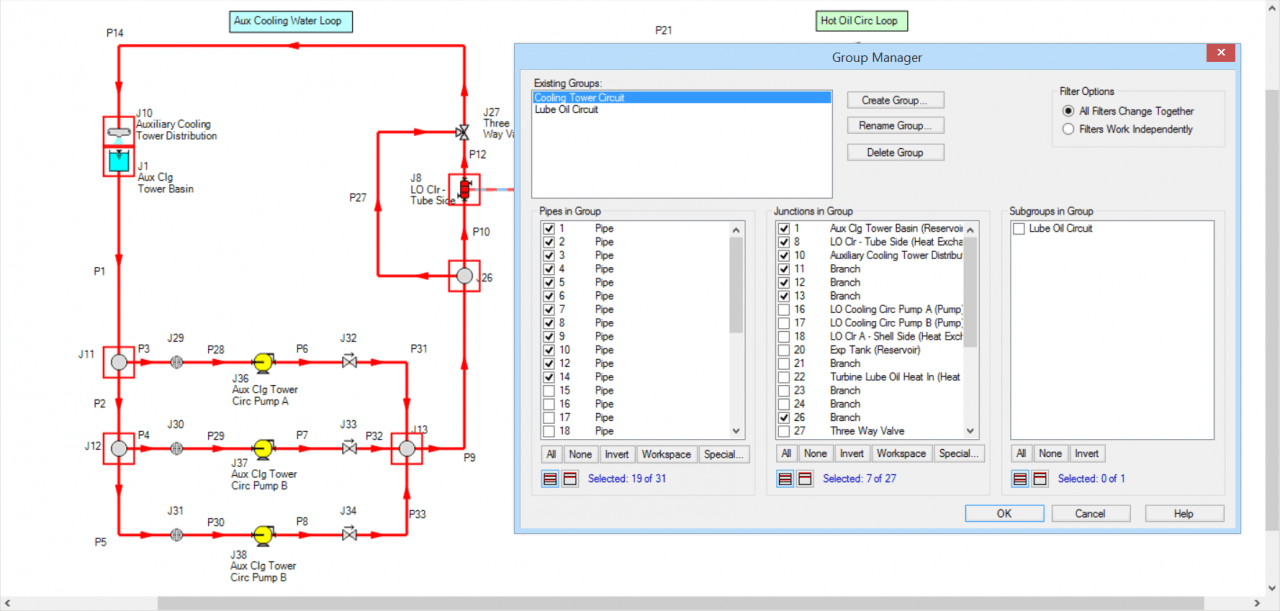
Then, select the pipes and junctions that make up the hot oil side. With those objects selected, click "Edit", then "Groups", then "Create" and give the hot oil loop a name.
After two separate groups for each loop have been created, the specific fluids that will be used for each group can now be defined. Click "Edit", then "Groups", then "Fluids". Check both boxes so that both fluid groups can be used.
For the cooling water circuit, click the box with the little dots in the "Fluid" column, then specify the fluid properties, like that in Figure 4. Any of the fluid options are available, except for "User Specified Fluid" (because the "User Specified Fluid" option does not model heat transfer).
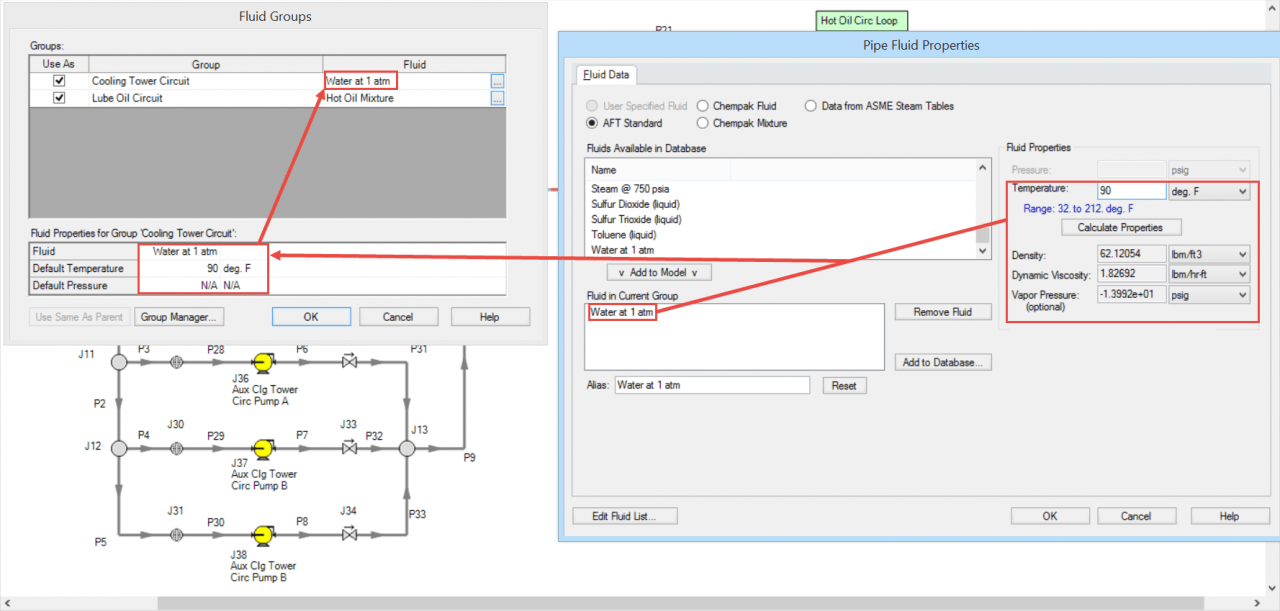
Then, specify the fluid properties for the hot oil loop by clicking on its box with the little dots.
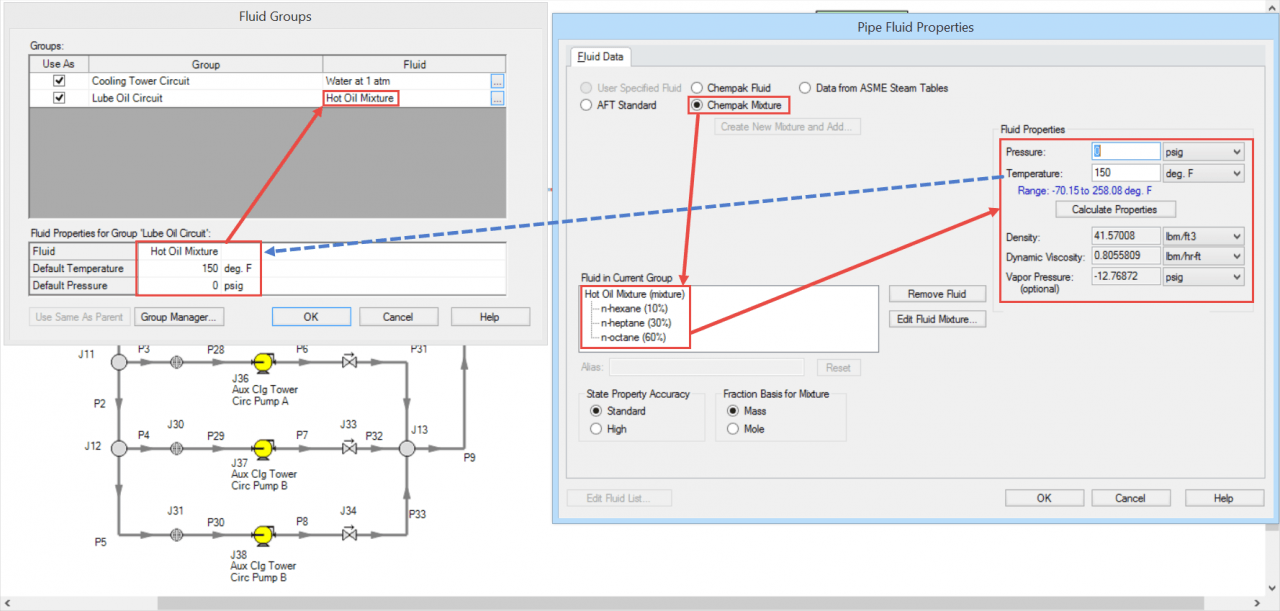
After a particular fluid has been chosen for each fluid group, click OK.
Now, the two heat exchangers can be "thermally linked" together.
Open one heat exchanger, and on the Thermal Data tab, specify one of the Effectiveness-NTU thermal models, then check the box to "Link to Heat Exchanger", and select the other heat exchanger from the drop-down menu that you want to link to. Then specify the required parameters. Figure 6 illustrates how to thermally link the cooling water loop tube side with a “Counter-Flow” thermal model and it will link to the Hot Oil Loop heat exchanger.
Then, do the same thing for the other heat exchanger (by linking back to the previous heat exchanger).
Finally, the model can run and this will allow simulation of two sides of one heat exchanger and their associated flow loops in a single model file!! Figure 7 shows that the heat transfer FROM the hot oil shell side of the heat exchanger equals the heat transfer TO the cold water tube side of the heat exchanger.
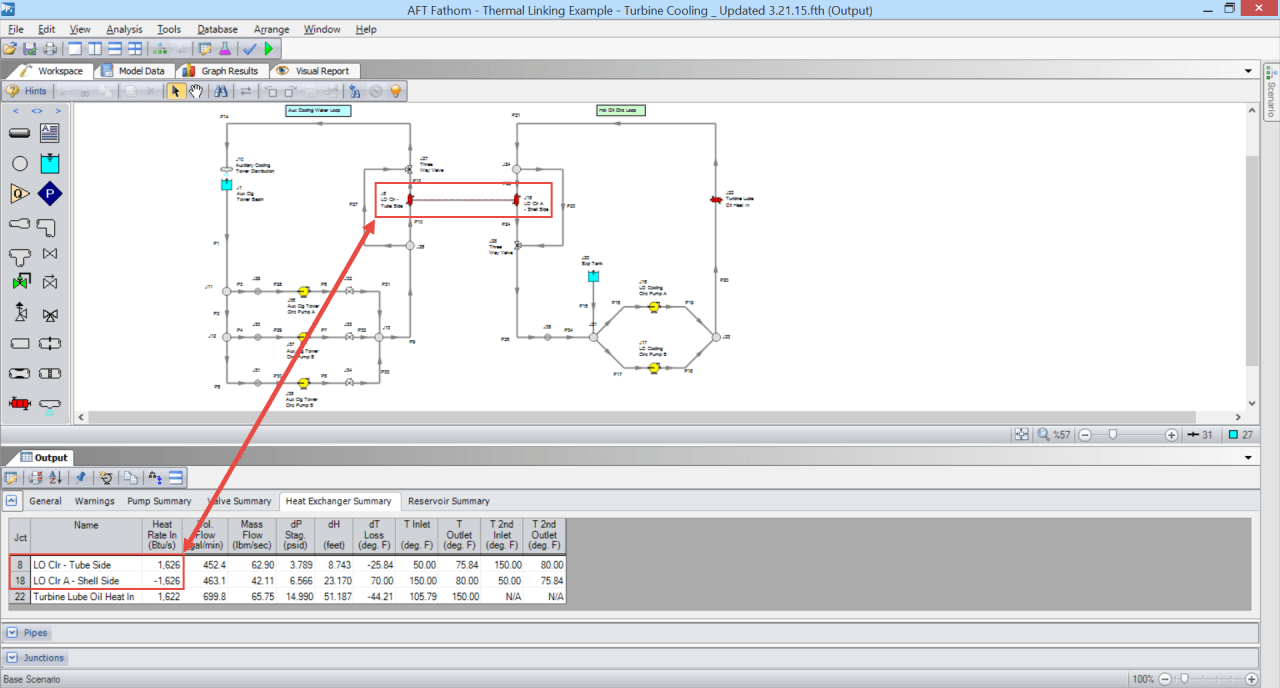



Comments 8
thanks for your help.
can i design same model without using hot side secondary heat exchanger, which in this case is j22, by just setting fluid temperature in supply tank??
Hi Devendra,
You could potentially build the same model without using J22 and set the temperature in the supply tank. However, keep in mind that in this particular model, there is a going to be a mixture temperature between the return flow path and the temperature from the supply tank. That temperature is lower than I wanted it to be, so I placed another heat exchanger downstream (J22) to heat the fluid backup.
Hi Ben, could you specify the detail of pipe diameters and other relevant data in order to let us check the result and use it as a exercise?
Hi Michael, right now, the model would require a license of the Chempak Database in order for it to be able to be opened with AFT Fathom 8. I will be working on modifying the model so that the Chempak Database would not be needed, and then I will zip up the model and attach it to the article and let you know so you can download it.
Hi Ben,
I am new to modeling heat exchangers in Fathom. My question is can we model water at elevated temperatures? I am finding when specifying your temperature you can only be in a range of 0-100 degrees C for water. I want to model fluids at higher temperatures but I am getting warnings from the software saying I am outside the allowable range. The program does not seem to take into account pressure when I am assigning a temp. Is there a work around or an add-in for Fathom?
Thank you,
Justin
Hi Justin,
If you are using an AFT Standard Fluid, then the thermophysical properties are temperature dependent only, and most of the fluid properties listed are at 1 atm (Water is at 1 atm for its properties). Therefore, at a constant pressure of 1 atm for the thermophysical properties, yes, you are limited to the boiling point, which is 100 deg C at 1atm.
However, if you choose the "ASME Steam Tables" option for the fluid (which is included with the standard software), then you do have the ability to specify both a pressure and a temperature. And with the ASME fluid option, you can model temperatures that are higher than 100 deg for when they have a higher boiling point at larger pressures.
Hope that helps! Any other questions, please feel free to email us at [email protected].
Thanks Justin and take care!
Thanks for sharing great information about heat exchangers. http://www.watco-group.co/